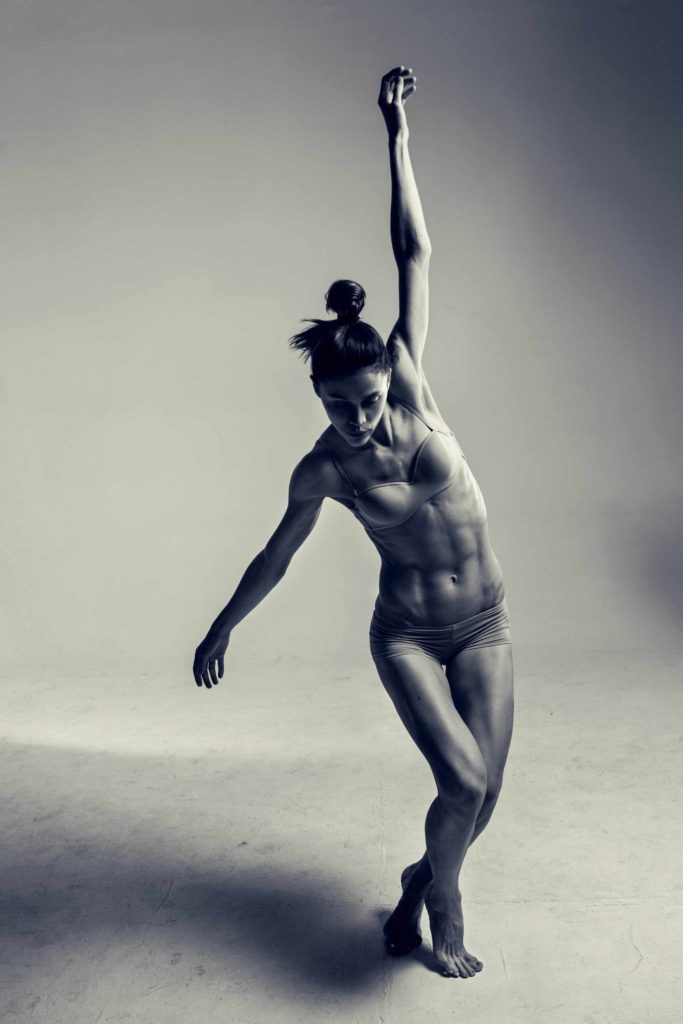
It can be difficult to find a lower body bodyweight workout that is actually challenging, especially if you work out at the intermediate or advanced level. This workout, however, brings all the punches. I employ lots of plyometrics, mixed in with some isometric exercises to really tire your muscles out, giving you a great workout that delivers results.
This workout (and others like it) will make your legs toned and tight—like a dancer. And you can do it in a tiny space. When I made up this workout, I was in my apartment with my whole family home, so I put myself in a teensy hallway and made it work.
I would put this at intermediate to advanced level but follow below for beginner modifications. There is always a way to substitute an exercise or movement if it’s too difficult or dangerous for you.
This workout has two parts, and each part is 15 minutes, both HIIT. There is technically a rest interval on both parts, but to make this extra fun (read: torturous), I made the rest be either an isometric exercise or a low-intensity one.
Instructions.
Part 1:
45&30×12 (15 min)
- Vertical leap
- Isometric squat
- One leg jump up L
- Isometric back lunge L
- One leg jump up R
- Isometric back lunge R
- Twist jump
- Bodyweight squat
Part 2:
40&20×15 (15 min)
- Triple jump lunge and jump up (3 jump lunges and jump up on the front leg)
- Alternating back lunge and lunge tap
- Side lunge and jump up L
- Side lunge step and twist L
- Side lunge and jump up R
- Side lunge step and twist R
Vertical leap

Squat down and bring your arms down to your sides. Spring your body up and simultaneously throw your hands up above your head and a bit back, and also shoot your legs back. In the topmost position, you should look like a star from the front and a bow from the side, with your feet and hands slightly behind the rest of your body. Come back down to a squat and repeat. These vertical leaps are one after the other. It’s basically a high-octane jump squat, and as you get tired, you won’t be as much of a bow. That’s ok.
Modifications.
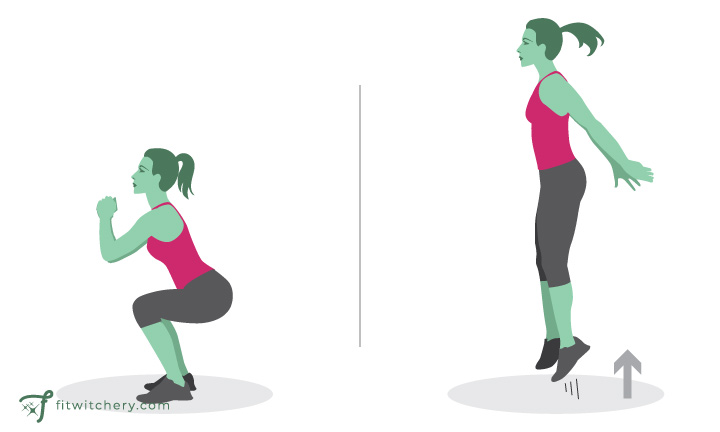
Beginner: regular squat. From a standing position, feet slightly wider than shoulder-width, bring your butt back and down until your thighs are parallel to the ground. Take care that your knees are over your feet and never protruding beyond. Return to standing and repeat.
Intermediate: Jump squat. From a standing position, feet slightly wider than shoulder-width, bring your butt back and down until your thighs are parallel to the ground. Take care that your knees are over your feet and never protruding beyond. Jump up from this position, straightening your body in the air, and return back to the squat position. Continue one after the other.
Isometric squat.
Hold a squat and don’t move.
One-legged jump-up.
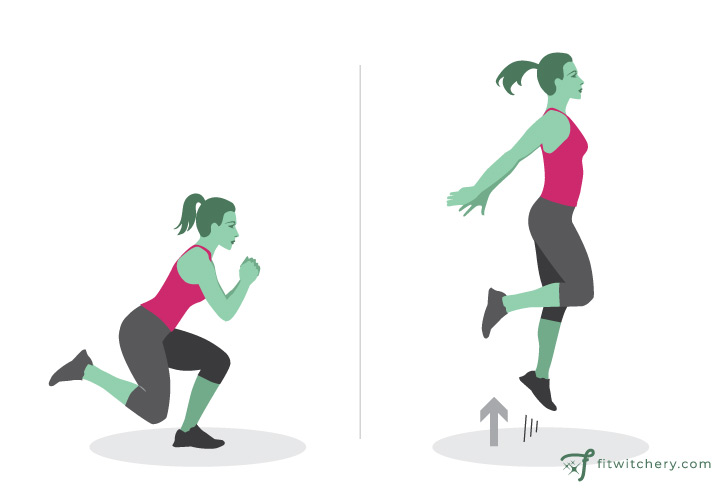
Standing on one leg, squat down. Your other leg should be bent and tucked under you. Bend your torso down as well, and now spring up in a jump, straightening your body in the air, and return to the recoil position and then return to standing on that one leg. Continue on the same leg. Don’t worry about getting super high off the ground; even a little jump is okay.
Modifications:
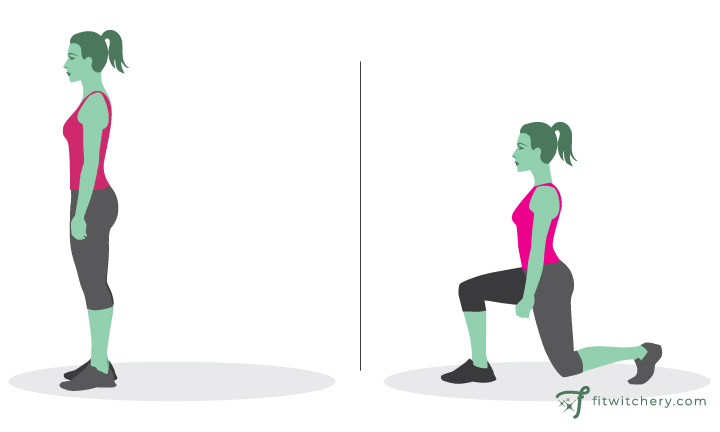
Beginner: Bodyweight back lunges. From standing, take one leg and step back until your knee is brushing or just above the floor. Your front knee should be at a 90 degree and your torso should be upright. Make sure your glutes are engaged. Return to standing.
Intermediate: Do assisted one-leg squats with no jump. You can either keep the other leg off the ground and keep your balance by holding a chair or bar. When you come up, don’t jump—just come to standing. Or, put your other foot on the ground off to the side, but don’t put full weight on it. So you’re doing squats where most of your weight is on one foot at a time. Be sure to keep good form and push that booty back rather than have your knees extend over your toes. Or, do back lunge and jump up. Do a back lunge, and when you return to standing, jump up on the front leg.
Isometric back lunge.
What it sounds like. Do a back lunge and hold for the duration of the interval.
Twist jump.

Jump squat and turn 180 degrees in the air. Turn back the opposite direction.
Modifications:
Jump squat with no twist or bodyweight squats.
Bodyweight squat.
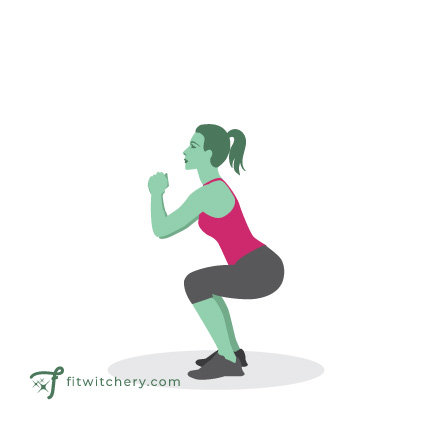
From a standing position, feet slightly wider than shoulder-width, bring your butt back and down until your thighs are parallel to the ground. Take care that your knees are over your feet and never protruding beyond. Return to standing and repeat.
Triple jump lunge and jump-up.

Start in a lunge position, with your knee at a 90-degree angle and your body upright and aligned over your hips. Jump up, propelling from the front leg, making sure to push through the heel and engaging your butt. Switch legs in the air and come down in a lunge on the opposite leg. Continue for three reps, and after the third, lift your back leg and jump up on the front leg, returning back to the same lunge position you were just in. Because you’re doing three jump lunges, each jump up should be on alternating legs.
Modifications:
Intermediate: Do three alternating back lunges and jump up on the front leg. Beginner: Do three alternating back lunges and stand up on the front leg, pulling in your hips and flexing your glutes.
Alternating back lunge and lunge tap.

Back lunge and stay low while bringing the back leg in and touching the floor next to the front leg. Return to the back lunge, and then return to standing by lifting the back leg completely and coming up.
Modifications:
Intermediate: None needed. Beginner: Regular back lunges, alternating.
Side lunge and jump up.
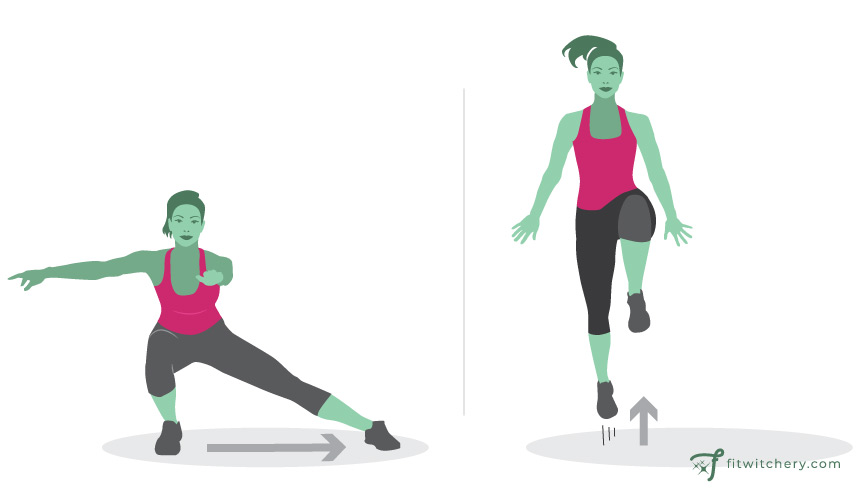
From standing, lift your right leg and bend down on your left leg so it’s parallel to the ground or close to it, and then tap your right foot out to the side. Stand back up on your left leg and jump up and return to standing on your left and go right into the next rep. These are tricky but effective. They are not great for the knees, so always make sure that your butt is back, you’re pushing through your heel, you’re engaging your glutes and that your knee doesn’t extend beyond your toes.
Modifications:
Intermediate: Side lunge and stand up. Flex your glute as you come up. Beginner: back lunge and jump up or stand up.
Side lunge step and twist.
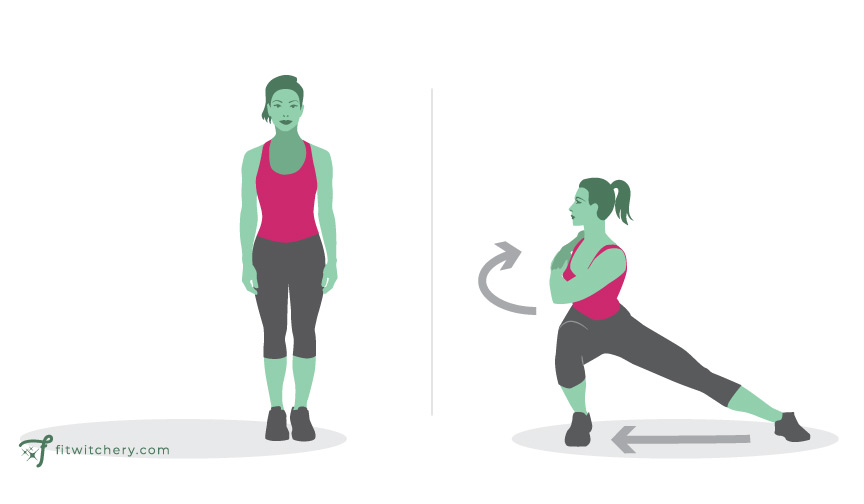
From standing, lift your left leg and take a giant step to the side and lunge down. Try to get your thighs parallel to the ground. At the bottom, twist your torso a bit to the left, arms up, which should engage that glute just a bit more. Push off your left leg to return to standing.
Modifications:
Skip the twist.
Record your times.
That’s it! Write down your scores and compare them next time you do the workout. Do lower body workouts (even bodyweight) no more than twice a week. Check out my other workouts here.
Happy workouting, chicas!


